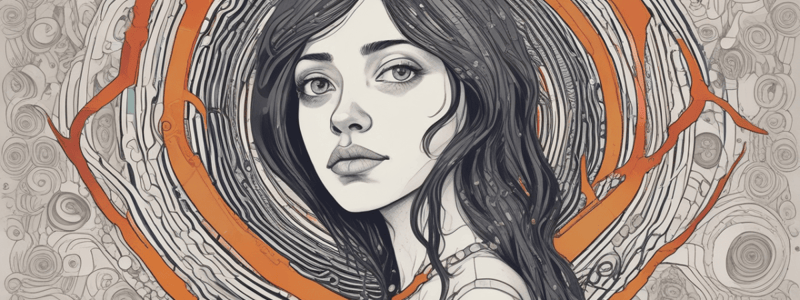Podcast
Questions and Answers
What is the primary neurotransmitter involved in the normal fear response to threatening stimuli?
What is the primary neurotransmitter involved in the normal fear response to threatening stimuli?
- NA (correct)
- 5-HT
- GABA
- Cortisol
Which brain region is responsible for planning and predicting, and is affected in Generalised Anxiety Disorder (GAD)?
Which brain region is responsible for planning and predicting, and is affected in Generalised Anxiety Disorder (GAD)?
- Prefrontal Cortex (correct)
- Amygdala
- Hippocampus
- Cerebellum
What is the characteristic feature of Post Traumatic Stress Disorder (PTSD)?
What is the characteristic feature of Post Traumatic Stress Disorder (PTSD)?
- Excessive and difficult to control anxiety about several events
- Somatic symptoms such as sweating and tachycardia
- Overactive 'fight or flight' response
- Re-experience of past stressful experiences (correct)
Which neurotransmitter is involved in the 'fight or flight' response and is overactive in Panic Disorder?
Which neurotransmitter is involved in the 'fight or flight' response and is overactive in Panic Disorder?
What is the primary brain region involved in fear conditioning and is affected in Post Traumatic Stress Disorder (PTSD)?
What is the primary brain region involved in fear conditioning and is affected in Post Traumatic Stress Disorder (PTSD)?
What is the lifetime prevalence of Generalised Anxiety Disorder (GAD)?
What is the lifetime prevalence of Generalised Anxiety Disorder (GAD)?
What is a characteristic of buspirone's side effect profile compared to benzodiazepines?
What is a characteristic of buspirone's side effect profile compared to benzodiazepines?
Which neurotransmitter is involved in the noradrenaline (NA) locus coeruleus pathway?
Which neurotransmitter is involved in the noradrenaline (NA) locus coeruleus pathway?
What is a characteristic of beta-adrenoceptor antagonists, such as propranolol, in treating anxiety disorders?
What is a characteristic of beta-adrenoceptor antagonists, such as propranolol, in treating anxiety disorders?
What is a characteristic of insomnia, especially chronic insomnia?
What is a characteristic of insomnia, especially chronic insomnia?
What is the effect of most hypnotics on REM sleep?
What is the effect of most hypnotics on REM sleep?
What is the characteristic of slow-wave sleep?
What is the characteristic of slow-wave sleep?
What percentage of obsessive compulsive disorder (OCD) cases are classified as severe?
What percentage of obsessive compulsive disorder (OCD) cases are classified as severe?
Which neurotransmitter is implicated in anxiety, panic disorders, and phobias?
Which neurotransmitter is implicated in anxiety, panic disorders, and phobias?
What is the primary mechanism of action of benzodiazepines in terms of GABA function?
What is the primary mechanism of action of benzodiazepines in terms of GABA function?
What is the primary indication for combining benzodiazepines with selective serotonin reuptake inhibitors (SSRIs) in anxiety disorders?
What is the primary indication for combining benzodiazepines with selective serotonin reuptake inhibitors (SSRIs) in anxiety disorders?
What is the primary risk associated with benzodiazepine overdose when combined with central nervous system (CNS) depressants?
What is the primary risk associated with benzodiazepine overdose when combined with central nervous system (CNS) depressants?
What is the primary mechanism of action of buspirone in anxiety disorders?
What is the primary mechanism of action of buspirone in anxiety disorders?
The majority of cases of Generalised Anxiety Disorder (GAD) are classified as severe.
The majority of cases of Generalised Anxiety Disorder (GAD) are classified as severe.
The neurotransmitter 5-HT is implicated in anxiety, panic disorders, and phobias.
The neurotransmitter 5-HT is implicated in anxiety, panic disorders, and phobias.
Buspirone is a selective serotonin reuptake inhibitor (SSRI).
Buspirone is a selective serotonin reuptake inhibitor (SSRI).
In generalised anxiety disorder, the prefrontal cortex is responsible for basic fear circuit.
In generalised anxiety disorder, the prefrontal cortex is responsible for basic fear circuit.
The primary mechanism of action of benzodiazepines is to increase GABA function.
The primary mechanism of action of benzodiazepines is to increase GABA function.
The neurotransmitter GABA is overactive in panic disorder.
The neurotransmitter GABA is overactive in panic disorder.
Benzodiazepines are commonly used as a first-line treatment for anxiety disorders.
Benzodiazepines are commonly used as a first-line treatment for anxiety disorders.
The hippocampus is affected in generalised anxiety disorder (GAD).
The hippocampus is affected in generalised anxiety disorder (GAD).
The 'fight or flight' response is primarily mediated by the neurotransmitter GABA.
The 'fight or flight' response is primarily mediated by the neurotransmitter GABA.
The combination of benzodiazepines with central nervous system (CNS) depressants can lead to respiratory depression.
The combination of benzodiazepines with central nervous system (CNS) depressants can lead to respiratory depression.
The lifetime prevalence of post-traumatic stress disorder (PTSD) is 4-7%.
The lifetime prevalence of post-traumatic stress disorder (PTSD) is 4-7%.
The amygdala is responsible for planning and predicting in anxiety disorders.
The amygdala is responsible for planning and predicting in anxiety disorders.
Buspirone is only effective in treating Generalized Anxiety Disorder (GAD) and has a better side effect profile than benzodiazepines.
Buspirone is only effective in treating Generalized Anxiety Disorder (GAD) and has a better side effect profile than benzodiazepines.
Beta-adrenoceptor antagonists, such as propranolol, are effective in treating the psychological symptoms of anxiety.
Beta-adrenoceptor antagonists, such as propranolol, are effective in treating the psychological symptoms of anxiety.
Insomnia can be transient or chronic, depending on the underlying cause.
Insomnia can be transient or chronic, depending on the underlying cause.
Rapid Eye Movement (REM) sleep is characterized by high muscle tone and increased cortisol levels.
Rapid Eye Movement (REM) sleep is characterized by high muscle tone and increased cortisol levels.
Most hypnotics increase the duration of REM sleep.
Most hypnotics increase the duration of REM sleep.
Slow-wave sleep is characterized by an increased metabolic rate and decreased growth hormone levels.
Slow-wave sleep is characterized by an increased metabolic rate and decreased growth hormone levels.
Flashcards are hidden until you start studying
Study Notes
Anxiety and Anxiety Disorders
- Anxiety is a normal fear response to threatening stimuli, characterized by autonomic reflexes, increased arousal and alertness, and defensive behaviors
- Clinically recognized anxiety disorders include Generalized Anxiety Disorder (GAD), Post-Traumatic Stress Disorder (PTSD), Panic Disorder, Obsessive-Compulsive Disorder (OCD), and Phobias
Generalized Anxiety Disorder (GAD)
- Lifetime prevalence: 4-7%, more common in females
- Characterized by excessive and difficult to control anxiety about several different events or activities
- Symptoms include worry, irritability, insomnia, and muscle tension
- GABA dysfunction is implicated in GAD
- Prefrontal cortex and amygdala are involved in the fear circuit
Post-Traumatic Stress Disorder (PTSD)
- Triggered by recall of past stressful experiences
- Characterized by re-experiencing the trauma, hyper-arousal, and avoidance of stimuli associated with the trauma
- Decreased hippocampus activity is observed in PTSD
Panic Disorder
- Sudden attacks of overwhelming fear with somatic symptoms such as sweating, tachycardia, and hyperventilation
- Often accompanied by agoraphobia
- Conditioned fear response is involved in panic disorder
Obsessive-Compulsive Disorder (OCD)
- Characterized by obsessions (recurrent and persistent thoughts) and compulsions (repetitive behaviors)
- Attempt to reduce anxiety by performing rituals
- Decision-making involves the cortex and basal ganglia
- Phobias are characterized by excessive and persistent fear of specific objects or situations
Benzodiazepines (BZD)
- Target GABA receptors, increasing inhibitory neurotransmission
- Effective in treating acute anxiety, but have side effects such as drowsiness, confusion, and amnesia
- Can be addictive and have a high risk of dependence
- Withdrawal symptoms include increased anxiety, tremors, and insomnia
Buspirone
- Effective in treating GAD, with a better side effect profile than BZD
- Acts as a partial agonist at 5-HT1A receptors
- Can take several weeks to produce a therapeutic effect
- Has a lower risk of dependence and withdrawal symptoms compared to BZD
5-HT Pathways in Anxiety
- 5-HT is implicated in anxiety, panic disorders, and depression
- 5-HT cell bodies in raphe nuclei project to areas involved in anxiety, including the hippocampus, amygdala, and prefrontal cortex
- Decreased 5-HT levels are associated with anxiety disorders
- SSRI and buspirone target 5-HT pathways to reduce anxiety
Studying That Suits You
Use AI to generate personalized quizzes and flashcards to suit your learning preferences.




